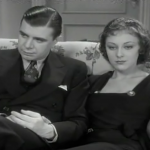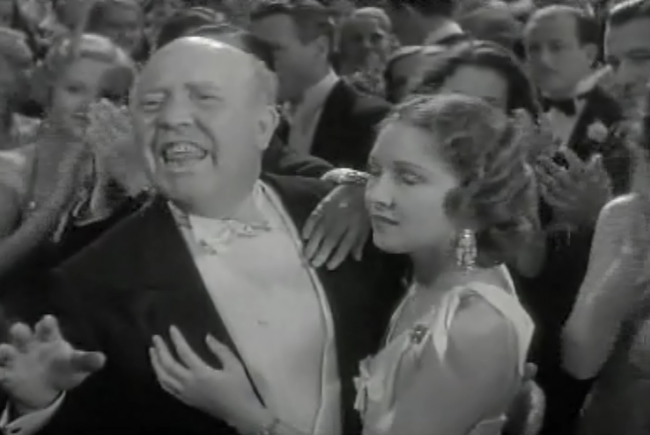 |
 |
 |
| Ted Taylor David Manners |
Judy Mason Ann Dvorak |
Peter Sturgis Ken Murray |
| Released by Warner Bros. | Directed by Lloyd Bacon |
||
Proof That It’s Pre-Code
- Saxophone player Ted Taylor thinks he’s getting a good reaction from a stage manager, but the guy’s only checking out a woman in a leotard stretching.
- Ted’s singing voice enraptures every woman in the nightclub but one:
- Speaking of, Tom gets a loving fan letter… from a man in prison.
- Out of context delights: “My jaw is sore from taking it so much.”
Crooner: A Real Microphony
“Why should they dance when I sing? […] You don’t realize, Judy, when I sing through that microphone, most of America is listening. Do you suppose that most of America would give a woop whether these people can dance or not? Or are they interested in my voice?”
Crooners aren’t my thing. I can get through a song or two of slow and sweet melodies, but there’s more to life than velvety male voices. A lot more, or so I believe.
Crooner is a goof on crooners created at the apex of their popularity. Here’s a rags– well, college– to riches story of a young man named Ted Taylor (Manners) whose band is floundering until one day he sings through a megaphone, creating a sensation both for the women in the audience and in terms of how quickly his head expands. His loyal girlfriend, Judy (Dvorak), stays with him until he becomes unbearable, while his clever press agent, Sturgis (Murray) pokes fun and makes the moves on Judy himself.
It’s a humility play, allowing the audience to root for Ted in the first half of the movie as he makes his way to the top and then enjoy his downfall as he becomes too big for his britches. David Manners, best remembered for his many turns as the hapless hero in the Universal horror movies, gives a nice comedic performance here full of carefully measured pomp. His transformation is unsurprising, and his downfall is both satisfying while remaining sympathetic.
I will admit that while watching this movie, I began to wonder why Pat O’Brien hadn’t been put in the Sturgis part, as he would have had a bit of more of a presence. At the same time I thought that Dick Powell would be better as the crooner since he has this good mix of puppy dog looks and punchability the part requires. That’s when I realized I’d just reinvented Twenty Million Sweethearts, which I hated, so you win this round, movie.
Crooner isn’t going to be on any ‘best of’ lists, nor can I imagine anyone working up much passion for it. Dvorak is wasted, Murray isn’t nasty enough, and the gags are pretty much just ‘okay’. It has a few clever moments, though, and a good central performance from Manners as his ego inflates and then pops. With Bacon’s snappy direction, the movie is a pleasant enough hour or so. Ya know.
Gallery
Hover over for controls.
Trivia & Links
- Manners’ singing voice is dubbed by Brick Holton.
- This is one of those rare films where both lead actors have their own fan sites. It’s true! Check out DavidManners.com and AnnDvorak.com for stills.
- In her Ann Dvorak biography, author Christina Rice bemoans Dvorak’s role as the devoted, patient girlfriend, in what was a slew of identical roles at Warner Bros. She does note:
In preparation for the role, Ann reportedly spent many evenings at KFWB, the Warner radio station in Hollywood, an experience said to have aided her greatly when the cameras started rolling, though it’s questionable if anything could have helped her with the thin part.
- Andre Sennwald in the Times calls this one, “shrewdly amusing.”
- David Kalat at TCMDB very helpfully discusses the history of crooning– and why it was so sexy and dangerous. (No, really!):
Now, just to be clear about this–my comparisons to modern-day pop stars are more than me just trying to make this 1932 relic seem “current.” Let me tell you a little about the peculiar moment of American pop culture in question. Just as the advent of cameras changed the relationship between actors and audiences, allowing performers to engage more intimately with a close-up, the advent of microphones radically changed the relationship between singers and their fans. Nightclub singers used to have to bellow with enough vocal force to project to the back of the dance floor. But with a microphone, a singer could dial that energy back and still be heard. Songs could be gentler, the soft inflection of a soothing male voice could now be appreciated–at least by the ladies. The joke was that men hated these crooners, but women melted in romantic bliss.
We can even be specific about this: we’re talking about such singers as Bing Crosby and Rudy Valle, whose sweet honeyed voices caused women across America to swoon. A generation later, their children would go into frenzies over the Beatles and Elvis Presley. The difference is minimal. Even the response of the public moralists was comparable–Boston’s notorious crusader Cardinal O’Connell condemned crooners as a threat to the nation’s moral safety; their appeal was too obviously rooted in raw lust. Between the Bible-thumpers and the frustrated men, the very word “crooner” became an epithet.
- Jeff Stafford at Movie Morlocks goes into the film’s parallels with real life crooner Rudy Vallee, probably best known to film buffs for his role in The Palm Beach Story and probably least known to film buffs for his role in The Phynx. (If you don’t know that movie, you just proved my point, so thanks.) Anyway, Stafford lays out some of the coincidences:
Like Ted, Rudy Vallee also started his own band while attending college (at Yale) and played the saxophone (and the clarinet too). In the beginning he didn’t really want to be a singer but discovered that most club owners at that time preferred bands with vocalists over traditional instrumental groups. Reputedly his bandmates tried to discourage him from singing – his voice was thin and not distinctive – but he persisted and became an accomplished singer of ballads and love songs. After he signed a record contract in 1928 and began performing on the radio, in addition to live appearances, his popularity grew rapidly, especially among women listeners who succumbed to his suave charm and smooth delivery. At some point in the late twenties he began using a megaphone to accent his phrasing and it became one of his trademarks.
Soon Vallee was mobbed by women everywhere he performed and it was inevitable that Hollywood would come calling. In 1929 he appeared in his first feature THE VAGABOND LOVER which helped mold the soon-to-be-stereotyped image of the crooner in movie musicals. Vallee’s singing style would soon inspire others to follow in his footsteps on screen such as Dick Powell and Bing Crosby and would endure as a trend in popular music until the forties. Audiences of today would probably find the appeal of this music inexplicable and in the case of CROONER, it’s not only silly but cloying – which is the movie’s inside joke. Despite the fact that several of the songs in the movie are written by such famous lyricists and composers as Al Dubin, Sammy Fain, and Harry Warren (and include “Three’s a Crowd,” “Banking on the Weather,”and “Sweethearts Forever”), they all end up sounding like the same song as sung by Ted. You long for some hot jazz or gutbucket blues. Anything to cut through these slow tempo serenades.
Awards, Accolades & Availability
- This film is an obscure one, though I imagine Warner Archive has their eye on it considering the risque content.
Comment below or join our email subscription list on the sidebar! |
||
 |
 |
 |
 |
 |
|









2 Comments
Barbara · May 21, 2016 at 12:12 am
How do we rent/buy these Pre-Code movies ??
Danny · May 23, 2016 at 10:08 pm
I usually mention it in the ‘Availability’ section, but some of these you just have to wait until it pops up on TCM. :/ Sorry.
Comments are closed.